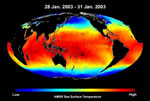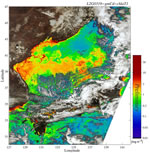Understanding the Earth System Mechanisms
Global environmental changes, such as the melting of the ice sheet in the polar region due to global climate warming, worldwide abnormal climates, ozone hole enlargement, tropical forest reduction due to deforestation, the progress of desertification, acid rain, and the decrease of wild biospecies, are beginning to cause major concerns for the future of the planet. Among these phenomena, global climate warming is the most serious problem for humankind.
 T
The
IPCCreports that global climate warming is progressing. A clear index of the warming progress is the melting of the ice sheet. Acute melting of ice in part of Antarctica has been observed by Earth observation satellites. Global phenomena such as ice melting, carbon dioxide increase, and increase of average atmospheric temperature are certainly occurring, but there is uncertainty whether these phenomena are temporary or permanent. Currently, these phenomena can be captured only as local events. Thus, global observation, investigation, and research are expected to begin as soon as possible. Observation data from ADEOS-II will be utilized as fundamental data for global environmental change forecasting.
The Earth system's constituents such as atmosphere, ocean, and land, are not independent, but rather interact with each other in a complex manner. Thus, it is important to understand the Earth as a system and approach these elements from that viewpoint. NASDA is striving to understand and forecast global climate change such as global warming through the ADEOS-II program.
The scientific goals of ADEOS-II can be summarized as follows.
- Regularly monitor the water and energy cycle as a part of the global climate system.
- Quantitatively estimate the biomass and fundamental productivity as a part of the carbon cycle, which plays an important role in global warming.
- Detect trends in long term climate change as a result of continuing the observations started by ADEOS.
 O
Of these three points, monitoring the water and energy cycle is the most important one for the ADEOS-II mission. Water-related parameters such as water vapor, precipitation, soil moisture, and snow depth retrieved from
AMSR data; cloud related parameters, water vapor, and aerosol estimated from
GLI data; sea surface stress parameters derived from
SeaWinds data; aerosol estimation from
POLDER data; and the ozone distribution estimated from
ILAS-II data will be of great use in achieving this goal.
SeaWinds data, which continues the observation of sea surface stress by
NSCAT on
ADEOS, will help us understand the ocean tidal cycling, as well.
 E
Estimating the fundamental productivity and chlorophyll, as a part of the carbon cycle, is another important goal for ADEOS-II. Multi-channel observation and 250-meter resolution data of
GLI will contribute significantly to achieving this goal. In addition,
ILAS-II data, which continues observation of ozone and minor species by
ILAS on
ADEOS, will help us understand the stratospheric chemistry as well.



